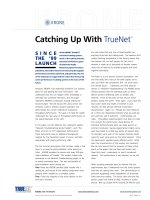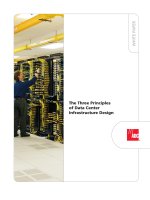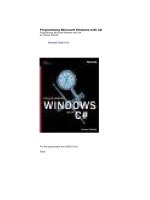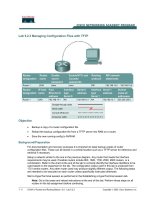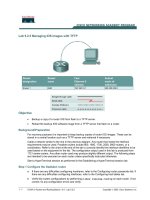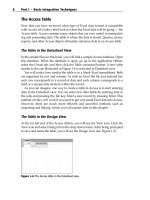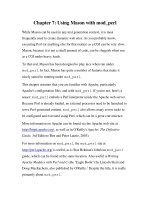Enterprise Integration with Ruby pptx
Bạn đang xem bản rút gọn của tài liệu. Xem và tải ngay bản đầy đủ của tài liệu tại đây (2.56 MB, 349 trang )
Enterpri se Integra tion with Ruby
A Pragmatic Guide
Maik Schmidt
The Pragmatic Bookshelf
Raleigh, North Carolina Dallas, Texas
Many of the designations used by manufacturers and sellers to distinguish their products
are claimed as trademarks. Where those designations appear in this book, and The
Pragmatic Programmers, LLC was aware of a trademark claim, the designations have
been printed in initial capital letters or in all capitals. The Pragmatic Starter Kit, The
Pragmatic Programmer, Pragmatic Programming, Pragmatic Bookshelf and the linking g
device are trademarks of The Pragmatic Programmers, LLC.
Every precaution was taken in the preparation of this book. However, the publisher
assumes no responsibility for errors or omissions, or for damages that may result from
the use of information (including program listings) contained herein.
Our Pragmatic courses, workshops, and other products can help you and your team
create better software and have more fun. For more information, as well as the latest
Pragmatic titles, please visit us at
Copyright
©
2006 The Pragmatic Programmers LLC.
All rights reserved.
No part of this publication may be reproduced, stored in a retrieval system, or transmit-
ted, in any form, or by any means, electronic, mechanical, photocopying, recording, or
otherwise, without the prior consent of the publisher.
Printed in the United States of America.
ISBN 0-9766940-6-9
Printed on acid-free paper with 85% recycled, 30% post-consumer content.
First printing, March 2006
Version: 2006-5-4
Für meine Eltern.
Ihr seid die Giganten, auf de ren Schultern ich stehe!
For my parents.
You a re the giants on whose shou l ders I stand!
Contents
Foreword viii
1 Introduction 1
1.1 What Is Enterprise Software? . . . . . . . . . . . . . . . . 2
1.2 What Is Enterprise Integration? . . . . . . . . . . . . . . 3
1.3 Why Ruby? . . . . . . . . . . . . . . . . . . . . . . . . . . 3
1.4 Who Should Read This Book? . . . . . . . . . . . . . . . 5
1.5 PragBouquet . . . . . . . . . . . . . . . . . . . . . . . . . 5
1.6 Acknowledgments . . . . . . . . . . . . . . . . . . . . . . 6
2 Databases 8
2.1 The Coupon Application . . . . . . . . . . . . . . . . . . . 9
2.2 Database Inter face (DBI) . . . . . . . . . . . . . . . . . . 25
2.3 Object-Relational Mappers . . . . . . . . . . . . . . . . . 28
2.4 Lightweight Directory Access Protocol (LDAP) . . . . . . 51
3 Processing XML 79
3.1 A Short XML Reminder . . . . . . . . . . . . . . . . . . . 81
3.2 Generating XML Documents . . . . . . . . . . . . . . . . 83
3.3 Processing XML Documents . . . . . . . . . . . . . . . . 95
3.4 Validating XML Documents . . . . . . . . . . . . . . . . . 127
3.5 Are There Alternatives to XML? . . . . . . . . . . . . . . 132
4 Low-Ceremony Distributed Applications 145
4.1 “I’d Rather Use a Socket” . . . . . . . . . . . . . . . . . . 146
4.2 Remote Procedure Calls Using HTTP . . . . . . . . . . . 159
5 Distributed Applications with RPC 179
5.1 Another Day, Another Protocol . . . . . . . . . . . . . . . 179
5.2 We Will Take No REST, Will We? . . . . . . . . . . . . . . 189
5.3 SOAP . . . . . . . . . . . . . . . . . . . . . . . . . . . . . . 200
5.4 CORBA, RMI, and Friends . . . . . . . . . . . . . . . . . 221
CONTENTS vii
6 Tools and Techniques 240
6.1 Internationalization and Localization . . . . . . . . . . . 240
6.2 Logging . . . . . . . . . . . . . . . . . . . . . . . . . . . . 261
6.3 Creating Daemons and Services . . . . . . . . . . . . . . 279
6.4 Build and Deployment Process . . . . . . . . . . . . . . . 286
6.5 Project Automation with Rake . . . . . . . . . . . . . . . 303
6.6 Testing Legacy Applications . . . . . . . . . . . . . . . . . 314
A Resources 321
A.1 Bibliography . . . . . . . . . . . . . . . . . . . . . . . . . 321
Fore word
A few years ago, I came across the Ruby programming language, and I fell in
love. Somehow, it just seemed to work the way my brain works— I can express
myself in Ruby more naturally and with less intervening fluff than in any other
language I know. I liked it s o much I persuaded Andy Hunt to coauthor a book
about it.
That was back in 1999. Since then, a lot has happened in the Ruby world.
The language went from release 1.6 to 1.8, and the standard library matured
into something world class. It gained a standardized documentation system, a
standard library distribution mechanism, and a fine build tool. I produced a
second edition of Programming Ruby to celebrate.
And now, for the first time, I can seriously say that Ruby is ready f or the
enterprise. The language is stable, the libraries are great, and there is a growing
pool of talented and enthusiastic Ruby developers, all rising to the challenge.
We see companies such as Amazon and EarthLink using Ruby for both internal-
and external-facing projects.
The problem is that—until now—there wasn’t much documentation on using
Ruby in the enterprise. Sure, you can always find the API documentation for a
library, but that doesn’t really explain the how and the why.
Now the situation has changed. With E nterprise Integration with Ruby, Maik
has done something I would have thought impossible. Not only has he doc-
umented just how to use Ru by to create new enterprise so lutions and to knit
together existing applications, but he has also documented the backgrounds to
all the technologies, along with how and when to use each.
I consider this book a worthy partner to Programming Ruby. With it, you’ll
exploit the power and flexibility of Ruby to create new solutions for your com-
pany in record time.
And, just as importantly, you’ll have fun.
Dave Thomas
The Pragmatic Programmers
There are two types of complex systems: those that have
grown out of simpler systems and those that do not work.
Unknown
Chapter
1
Introduction
Have you ever worked for a big enterprise? Do you remember your
expectations as you walked into w ork on that first day? Whistling as
the sun shone brightly, you might have been thinking, “It will be great
to work for <company name here>. They will have a professional envi-
ronment where coffee i s free and w here every system has been specified
accurately, implemented carefully, and tested thoroughly. Hmmmm
I wonder which database and programming language they use.”
After your fifth cup of free coffee (around 9:07) you came to realize that
the real world looks completely dif ferent from your expectations. Typi-
cal enterprises use dozens, h undreds, and sometimes even thousands
of applications, components, services, and databases. Many of them
were custom-built in-house or by third parties, some were bought, oth-
ers are based on open source projects, and the origin of a few—usually
the most critical ones—is completely unknown. A lot of applications
are very old, some are fairly new, and seemingly no two of them were
written using the same tools. They run on heterogeneous operating sys-
tems and hardware, they use databases and messaging systems from
various vendors, and they were written in completely different program-
ming languages.
The reasons for this are manifold. You can find countless books that
explain why th e situation is so bad. You can even find books claim-
ing that th ey help you prevent such chaos. This book uses another
approach. We will not help y ou clean up this mess, but we will help
you deal with the problems pragmatically. Instead of complaining that
valuable data is spread across different database schemas or across
databases from several vendors, we will write code that integrates it. We
will take it even a step further and write new applications that aggregat e
WHAT IS ENTERPRISE SOFTWARE? 2
all your existing resources. It doesn’t matter if we have to use relational
databases, LDAP repositories, XML files, or web services based on dif-
ferent protocol standards. We will blend data from multiple, disparate
databases to create new business knowledge.
Along the way we’ll show you how to solve all the small day-to-day
problems. These are the issues that occur over and over again, espe-
cially when developing enterprise software. We will access relational
databases such as Oracle and MySQL, and we will work with LDAP
repositories. We’ll show you how to do application logging, how to
deploy your software, how to automate tedious and error-prone tasks,
and how to survive in an international environment . Oh, and as you
might have guessed already from the book’s title, we will use Ruby to
accomplish all these feats.
1.1 What Is Enterprise Software?
In Patterns of Enterprise Application Architecture [Fow03], Martin Fowler
writes, “Enterprise applications are about the display, manipulation,
and storage of large amounts of often complex data and the support or
automation of business processes with that data.”
That’s a concise but nevertheless abstract definition, because every
nontrivial piece of software has to st ore, manipulate, and display data.
Video games do nothing else (and modern video games also need huge
amounts of data that often can get complex). The key point in the pre-
vious definition is the second part: the data in enterprise applications
is used for business processes and not for rendering alien spaceships.
Unsurprisingly, there are more differences between enterprise applica-
tions and other types of software. For example, enterprise applications
are often created only for a small user group that is in close contact
with the development team, implying the developers know their cus-
tomers very well. In extreme cases programs are written for only a
single person (special report gener ators for the CEO, for example).
Enterprise software demands a certain set of tools. Large amounts
of data—complex or not—have to be stored somehow and somewhere.
Often it is st ored in relational databases, but it can also be in plain-text
files or LDAP repositories. In addition, modern enterprise softwar e i s
often based on distributed architectures consisting of many small to
midsize components that perform specialized tasks and that are con-
WHAT IS ENTERPRISE INTEGRATION? 3
nected by some kind of middleware such as CORBA, RMI, SOAP, and
XML-RPC.
Obviously, as an enterprise software developer, you’re better off if you
know how to deal with such technologies. You shouldn’t be troubled by
the details of reading from a relational database or accessing an LDAP
repository. Mastering skills such as these help you concentrate on the
fun stuff—the application itself.
1.2 What Is Enterprise Integration?
Enterprise integration is a rather vague term and cannot be defined in
a strict mathematical sense. Simply put, it happens whenever you use
an existing enterprise resource to achieve some results. If you use an
existing database or web service in your application, you’re perform-
ing enterprise integration. If you build a new component that is used
by other pieces of your existing architecture, you’re doing enterprise
integration, too.
Integration needn’t just happen inside a single enterprise. It’s quite
possible—and not too unusual—that the software or data of two differ-
ent enterprises has to be integrated. If you’re using a payment gateway
to bill your customers, for example, you’re effectively integrating enter-
prise software.
You might ask yourself whether every development activity in an enter-
prise environment is some kind of enterprise integration. There are a
few exceptions. Enterprise integr ation does not happen when you build
a completely new piece of software from scratch, for example. In reality
this case i s rare, but from a theoretical point of view this is the only
clear exception.
Enterprise int egration often means integration with standard software
such as databases, LDAP repositories, message queues, ERM systems,
and so on. If you’re using one of these technologies, chances are good
that you’re doing some enterprise integration.
1.3 Why Ruby ?
Most enterprise software running today was written in languages such
as COBOL, C/C++, and Java. Because of its distr i buted nature, enter-
prise software often makes it easy to use new tools and programming
WHY RUBY? 4
languages. When you have to create a small stand-alone application—
one that relies only upon an existing database, SOAP service, or LDAP
repository—it almost doesn’t seem to mat ter whether you were to write
it in C++, Java, or Ruby. But if you look into it more deeply, dynamic
languages such as Perl, Python, and Ruby have many advantages,
especially in enterprise environments:
• They are in terpreted and do not need a compile phase, which
increases development speed tremendously. After editing your
program, you can see the results of your changes immediately.
• Enterprise software is about munging data. Dynamic languages
are designed to handle data and include high-level data types such
as hashes.
• Memory management is dealt with by the language. This is a great
advantage over languages such as C++ where you have to specify
the length of each string you read from a database. Dynamic lan-
guages prevent waste and result in more concise, more robust,
and more secure software.
• Software written in dynamic languages is installed as source code,
so you always know exactly which version is currently runnin g on
your production system. Gone are the days when you had to guess
whether a certain binary executable is the right one.
We will show you Ruby’s strengths and how Ruby helps you accom-
plish many tasks much faster, more elegantly, and with more fun than
with any other programming language available today. But, even more
important, we will also tell you about Ruby’s weaknesses. Ruby is com-
paratively young, and although the core of the language is mature and
lots of excellent libraries are available, many features are still missing
or incomplete.
Although there is no industry standard for enterprise programming
with Ruby (as there is with J2EE or .NET), everything you need is
readily available. The most important libraries come with every Ruby
distribution, and the standard distribution has grown rapidly over the
last years. All the other stuff can be found in public places such as
RubyForge
1
or the Ruby Application Archive.
2
1
2
WHO SHOULD READ THIS BOOK? 5
1.4 Who Shou l d Read This Book?
This book was written for experienced enterprise developers who know
Java, C#, or C++ but don’t know much Ruby (alt hough you should
probably have read Programming Ruby [
TFH05]). We assume you are
familiar with relational databases and have at least an idea of what
LDAP is. Maybe you do not know RELAX NG, but you understand the
concepts of XML and what well-formed, SAX2, and DOM mean.
You’ve probably used tools such as object-relational mappers. Maybe
you’re familiar with Enterprise Java Beans (EJB), Java Data Objects
(JDO), and so on. Maybe you’re fed up with editing configuration files
instead of coding. You are looking for better ways to integrate the exist-
ing resources in your company, and you ar e looking for better ways to
quickly create new and fancy applications based on all the wonderful
stuff you already have.
Depending on the tools you’ve used to build your architecture, differ-
ent choices are available for the integration process. If you’re using
message queues, you have a lot of freedom and flexibility for i ntegrat-
ing your services and software with other s. The same holds true for
all kinds of w eb service protocols. It’s slightly different with databases,
because they usually do not offer i nterfaces as clean as message-based
systems do. Sometimes you have to access tables directly, and some-
times you have to use a set of stor ed pr ocedures written in a proprietary
database programming language.
In this book we do not talk about sophisticated messaging patterns.
Instead, we cover the basics. We show you how to use databases, web
services, XML files, and all the other legacy stuff you want to combine
for building new applications.
1.5 PragBouque t
To make things more interesting and tangible, we’ve founded an imag-
inary company called PragBouquet. It sells flowers from a web shop.
Customers from all over the world can order flowers and send them to
people living in the United States.
PragBouquet’s business demands a lot of components and services. It
depends on several partners, too. Their current infrastructure is shown
in Figure
1.1, on t he following page. Customers place orders in the web
shop. The shop communicates with the central order system. Because
ACKNOWLEDGMENTS 6
Figure 1.1: PragBouquet Infrastructure
PragBouquet has no billing system, the order system uses an external
payment gateway to char ge orders. In parallel, the production system
is informed of new orders, and busy florists create wonderful bunches
of flowers. Eventually, the floral goods are picked up by a parcel service
and are delivered to the happy recipient.
This is only a rough overview. We’ll show sin gle components in more
detail when necessary.
1.6 Acknowledgments
First, I’d like to thank Dave Thomas and Andy Hunt for giving me th e
opportunity to write th i s book for the Pragmatic Bookshelf. Working
with th em has been both an honor and a pleasure. I couldn’t imagine
better or more professional working conditions.
It would be impossible to write a book about software for enterprise
integration without the software itself. The following g entlemen kindly
made their ingenious w ork public for free and have always responded
quickly and accurately to all my questions: Yukihiro “Matz” Matsumoto,
Will Drewry, arton (the author of Rj b), Sean Russel, Ian Macdonald,
Takaaki Tateishi, Thomas Uehlinger, Jim Weirich, Nikolai Lugovoi, Matt
Mower, Daniel Berger, why the lucky stiff, Minero Aoki, Michael Neu-
ACKNOWLEDGMENTS 7
mann, Kubo Takehiro, Tomita Masahiro, David Heinemeier Hansson,
Hiroshi Nakamura, John W. Small, Takahashi Masayoshi, Gotou Yuu-
zou, Yoshida Masato, and Grant McLean.
Please join me in thanking my reviewers: Frank Tewissen, Matthias
“Matze” Klame, Uwe Simon, and Kaan Karaca did an awesome job!
Without their corrections and suggestions this book wouldn’t be half
as good.
A loud “Thank you very much!!!” goes to all the people who sent
errata and suggestions during the beta book process: Lee Grey, Hoang
Uong, Ola Bini, Ron Lusk, John Athayde, Blair Zajac, Jim Weirich, Pat
Podenski, Gregory Brown, Lachlan Dowding, Sean, Eldon, Henry Chiu,
Stuart Halloway, Raymond Brigleb, Ken Barker, Peter Morelli, Er i c-
Olivier Lamey, Jim Kimball, Wilson Bilkovich, John Douthat, Remco
van ’t Veer, Mark Mayo, Joe Duhamel, Carl Graf, Adam Keys, Manirith
Nuth, Andres Paglayan, Dána Watanabe, Mike Stok, Eric Kramer, and
Urban Hafner.
Perhaps there are authors who w rite books in isolation under a rock
or on a lonesome island. Fortunately, I didn’t, and I got invaluable
support from a lot of w onderful people. I am deeply grateful to my
parents (this one is for you); my sister, Yvonne Janka (yet another
book you won’t read?); my brother, André Schmidt (for relaxing shop-
ping/running tours and even more relaxing evenings with “the boys”);
Christian and Agnieszka Rattat ( for being true friends when I needed
them most); Frank Tew i ssen ( for listening patiently and for advising
carefully); Manu (for being “die Manu”! Heja BVB!); AleX Reinartz (I’m
looking forward to the next decades); Bettina Hamidian and Corinna
Lorscheid (for insightful talks and lots of fun); Katja Wevelsiep (let’s
have a coffee tomorrow, OK?); Frank Möcke (for giving me the opportu-
nity to publish texts in my mother tongue); Dr. Andreas Kötz (for your
appreciation); and the “gleis drei” staff (for providing a perfect proof-
reading environment).
Mia: I promise to w rite until I finally learn to clearly express how excit-
ing and wonderful the last months have been.
Chapter
2
Databases
Database management systems are one of the oldest and most widely
used applications in information technology—they are indispensable to
enterprises. It’s nearly impossible to do some serious enterprise inte-
gration without touching some kind of database directly or indirectly.
Various types exist (relational databases, object-oriented databases,
directory services, XML databases, and hash databases such as Berke-
ley DB). They differ mainly in the way data is organized and accessed
internally. Under the hood, though, they are all similar: data is stored
in some kind of file system and is accessed through a special layer,
often over a network. You can find one or more of the different types
in every company, but relational databases are by far the most popular
ones in use today.
Although it ’s often tedious, repetitive, and error-prone work, access-
ing databases is, in prin ciple, easy. You open a connection, create
and execute some statements, read and process some data, and finally
free all resources occupied. At l east, that’s how the Gods Of Persistence
wanted it to be. But real life in our sinful world looks different. Informa-
tion and business l ogic are often spread across different schemas and
databases. To make things even w orse, many companies use products
from multiple vendors. This happens for various reasons: they want
to prevent vendor lock-in, the company is the product of a corporate
merger, different departments prefer different tools, and so on.
Unfortunately, PragBouquet is no exception. Its data is stored in both
Oracle and MySQL databases. In this chapter we will show you not only
how to directly manipulate different types of databases but also how
to access them using more advanced tools such as object-relational
mappers and database abstraction layers.
THE COUPON APPLICATION 9
2.1 The Coupo n Application
PragBouquet’s business has been doing well, but business can always
be better, can’t it? To boost sales, the marketing department wants to
send a coupon to every customer who has used the online store but
hasn’t used it i n the last six months. People who asked not to receive
e-mail from us should not get an e-mail.
That does not sound too difficult. PragBouquet already has a mass-
mailing program that expects a CSV (Comma-Separated Values) file
containing e-mail addresses, customer names, and text to be sent.
The problem becomes selecting names and e-mail addresses of all cus-
tomers who did not place an order in the last six months, filtering out
those who do not want to be e-mailed, and writing the rest to the CSV
file.
Instantly you’ve fired up your favorite text editor thinking that thi s is a
great opportunity to strengthen your Ruby skills. Creating CSV files is
a breeze, and selecting some data sets from a database should not be a
problem either. So you ask your database administrator where you can
Figure 2.1: Coupon Application Workflow
THE COUPON APPLICATION 10
find the information you need, and he takes you down a peg or two. He
tells you that for historical reasons (a euphemism for “Nobody knows
why”) the in formation you need is spread across two databases. Cus-
tomer data and order data are stored in an Oracle database, but the
white l i st containing the e-mail addresses of all customers who want
to receive e-mail from PragBouquet is stored in the web shop’s MySQL
database. You scribble a bit on y our notepad and realize that the sys-
tem architecture has to look like Figure
2.1, on the page before.
Exploring the Environment
You decide to start with the Oracle part. Before moving on, you want to
take a closer look at the structure of the order database. Your database
administrator told you that the relevant tables are called customers and
orders. He gave you plenty of Microsoft Word documents describing
every single table in the order database. Despite this you look at the
current state of af fairs yourself using SQL*Plus, Oracle’s SQL shell:
C:\> sqlplus scott
SQL*Plus: Release 9.2.0.1.0 - Production on Sat Jun 4 16:00:04 2005
Copyright (c) 1982, 2002, Oracle Corporation. All rights reserved.
Enter password:
Connected to:
Personal Oracle9i Release 9.2.0.1.0 - Production
With the Partitioning, OLAP and Oracle Data Mining options
JServer Release 9.2.0.1.0 - Production
SQL>
describe customers
Name Null? Type
ID NOT NULL NUMBER(38)
NAME NOT NULL VARCHAR2(64)
SURNAME NOT NULL VARCHAR2(128)
STREET NOT NULL VARCHAR2(128)
HOUSE_NUMBER NOT NULL VARCHAR2(10)
POSTAL_CODE NOT NULL VARCHAR2(10)
CITY NOT NULL VARCHAR2(128)
STATE VARCHAR2(20)
COUNTRY_CODE NOT NULL VARCHAR2(2)
EMAIL NOT NULL VARCHAR2(128)
CREATED DATE
THE COUPON APPLICATION 11
Why Didn’t We Use a Standard Product?
You m ight be asking yourself whether it’s a good idea for
PragBouquet to have created its own customer an d order
database. Wouldn’t it be much easier to buy a solution off the
shelf? Customer data is at the core of every enterprise, and
many processes rely upon it. It’s need ed for billing, for statistics,
for troubleshooting, and so on. Although many bi g compa-
nies offer software for customer relationship management, it’s
never a b ad idea to think ab out building your own customer
database. No product will fit your needs better than your own,
and no product will ever be as flexible as yours.
SQL> describe orders
Name Null? Type
ID NOT NULL NUMBER(38)
CUSTOMER_ID NOT NULL NUMBER(38)
STATE NOT NULL NUMBER(38)
CREATED TIMESTAMP(6)
No big surprises here. Obviously, customers are character ized mainly
by their address data, and we guess that the t ables are connected using
column customer_id in t able orders.
Determine the Winners
If we’re going to use a Ruby program to extract informati on from an
Oracle database, we’ll need a library that connects our code to the
underlying Oracle API. There are currently three different Ruby mod-
ules for Oracle:
• Oracle by Yoshida Masato
1
• Ruby/OC I8 by Kubo Takehiro
2
• Ruby9i by Jim Kain
3
The main difference between these libraries is their support (or lack
thereof) for new data t ypes. Gone are the days w hen you could store
1
/>2
/>3
/>THE COUPON APPLICATION 12
Storing Addresses—A Plea from the Rest of the World
Even though addresses are critical for many purposes, their
data representation is often performed carelessly and with-
out foresight. In particular, asp ects of internationalization are
often forgotten, because designers and developers normally
do not know a lot about the administrative characteristics of
their neighbors.
For example, Germany is a federal country divided into 16
states, but to the Germans the different states do not mean
a lot. They aren’t part of an ad dress, they do not occur on
envelopes, and you do not have to put them into a web form
when ordering something from an Internet shop. It’s not surpri s-
ing that German customers get annoyed by web forms insisting
on a state. When working in an internati onal environment, it’s
better to make the state optiona l.
There is no international standard for the representation of a n
address . In Germany, for example, a street address is the street
name followed by a blank followed by the house number. In
Italy, there’s a comma between the street name and the house
number. Other countries put the number before the name.
It’s nearly impossible to automatically separate street na mes
and house numbers afterward, because house numbers can
contain n early arbitrary characters.
Another aspect of addresses that is forgotten sur prisingly often
in this context is that addresses represent geographical objects.
Geographical objec ts have coordinates, locations that are
becoming increa singly important as we move into a world
using location-based services. If you want to offer location-
based services to your customers some day, you’ll have to
determ ine the geographical position of their a ddresses. For
many cities it’s possible to locate an object down to the indi-
vidual house number.
Please, don’t misunderstand me: you should not try to come up
with a solution that will work with every possible address format
in the world (I think that would probably be impossible), but
you should at least take a closer look at the countries you’re
potentially worki ng in.
THE COUPON APPLICATION 13
only small strings and numbers in your database. Nowadays you can
store complete books or MP3 files in CLOB (Character Large Object) or Character Large Object
BLOB (Binary Large Object) columns. Major versions of the Oracle Call
Binary Large Object
Interface (OCI) also differ in other areas, such as security and perfor-
Oracle Call Interface
mance.
In th i s book we’ll use Kubo Takehiro’s Ruby/OCI8 driver—it’s actively
maintained, it runs on many platforms, and it provides a lot of func-
tionality. It comes in two flavors: a low-level and a high-level API. The
low-level API directly reflects the Oracle C library, and we won’t show
its usage, because the high-level API is probably more convenient to
use.
Let’s dive into Ruby now and see how we can identify the customers
who should get a coupon:
File 16
Line 1
require ' oci8'
-
-
connection = OCI8.new(' maik' , ' maik' )
-
cursor = connection.exec(<<-SQL)
5
select a.id, a.name, a.surname, a.email
-
from customers a, orders b
-
where a.id = b.customer_id
-
and b.created < sysdate - 180
-
and b.created = (
10
select max(created)
-
from orders
-
where customer_id = a.id
-
)
-
SQL
15
-
while row = cursor.fetch do
-
puts row[3]
-
end
-
20
cursor.close
-
connection.logoff
This code produces something like this:
Here we have a typical example of accessing a database. It would
look similar in every modern programming language. First w e estab-
lish a database connection by calling the new() method of class OCI8
(connect( ) would have been a much better name, but for the moment
we have to live with it). The new( ) method returns a connection object
THE COUPON APPLICATION 14
that can be used to communicate with the database server and to create
other database objects, such as statements and cursors.
The SQL statement joins the tables customers and orders and returns
only those customers whose last order is older than 180 days. The sub-
select identifies the most current entry for each customer and makes
sure that every customer is returned only once.
As y ou can see, SQL statements can be executed directly by calling the
exec( ) method of an OCI8 connection. For SELECT statements, exec( )
returns a so-called cursor representing a result set on the database
server. Clients can move through a result set by calling fetch( ) on the
cursor object. After the last row has been read from the cursor, fetch( )
returns nil.
Finally, we close our cursor to free valuable resources on the data-
base server. Cursors are resources like file handles and are in limited
supply. If you’re a bad citizen and fail to free these resources, Oracle
will raise an exception sooner or later.
Admittedly, our example is concise and expressive, but using Ruby’s
iterators automatically leads you to a more elegant solution with less
explicit resource management:
File 17
Line 1
require ' oci8'
-
-
connection = OCI8.new(' maik' , ' maik' )
-
sql = <<-SQL
5
select a.id, a.name, a.surname, a.email
-
from customers a, orders b
-
where a.id = b.customer_id
-
and b.created < sysdate - 180
-
and b.created = (
10
select max(created)
-
from orders
-
where customer_id = a.id
-
)
-
SQL
15
-
-
num_customers = connection.exec(sql) do |row|
-
puts row[3]
-
end
20
-
-
puts "Found #{num_customers} coupon recipients."
-
connection.logoff
This code produces the following:
THE COUPON APPLICATION 15
Found 2 coupon recipients.
When exec( ) is called as an iterator—wi th a code block—it ret urns the
number of rows selected. The code block automatically gets each row
fetched as a parameter, and you no longer have to close the cursor
explicitly. Actually, you don’t even notice that you’r e working with a
cursor.
Enhancing F l exibility
OK, our first example works. We know wh ere to get the data from
and we know how to get it, so let’s turn our little script into softw are.
Now we have to replace the constant 180 days with something more
dynamic. To do this, we could create the string containing the SQL
statement on the fly, substituting in the time value, but this approach
has some serious drawbacks.
As we already know, the SQL statement gets transferred over the net-
work to the database server whenever we call exec( ). Then it gets
parsed, analyzed, optimized, and executed, and eventually the result
is sent back to th e client.
Actually, modern database servers try to optimize a lot. Part of t his pro-
cess is the creation of a query execution plan for every statement they query execution plan
receive. Current Oracle versions even try to compress the result sets
before sending them back to the client to decrease bandwidth and pro-
cessing time. For SQL statements that are executed often, this means
we could gain a lot if the statement could be parsed, analyzed, and
optimized only once.
Furthermore, building SQL statements on the fly often creates danger-
ous security holes. What if someone uses a web f orm to pass us the
following string for the number of days?
' 180; delete from customers; commit;'
In the worst case, the database server will happily execute the malicious
statement, giving you an excellent opportunity to check whether your
backup system is working properly. This common kind of attack is
called SQL injection. SQL injection
Fortunately, it is possible to circumvent all these disadvantages by
using prepared statements. We transmit a stat ement template to th e prepared statements
server, where it is parsed, analyzed, and optimized. The server then
THE COUPON APPLICATION 16
sends back a statement handle. All the dynamic portions of our state-
ment are replaced by placeholders. Whenever we want to execute our
statement, w e send t he server only the handle and the actual values for
our placeholders:
File 15
Line 1
require ' oci8'
-
-
Customer = Struct.new(:id, :name, :surname, :email)
File 15
Line 1
class CustomerFinder
-
def initialize(connection)
-
@find_stmt = connection.parse(<<-SQL)
-
select a.id, a.name, a.surname, a.email
5
from customers a, orders b
-
where a.id = b.customer_id
-
and b.created < sysdate - :days
-
and b.created = (
-
select max(created)
10
from orders
-
where customer_id = a.id
-
)
-
SQL
-
end
15
-
def find(days)
-
@find_stmt.bind_param(' :days' , days)
-
@find_stmt.exec
-
customers = []
20
while row = @find_stmt.fetch do
-
customers << Customer.new(*row)
-
end
-
customers
-
end
25
end
First of all, we have inserted a placeholder (:days) into the SELECT state-
ment. Second of all, we have created a prepared stat ement by calling
parse(sql) on our connection. This method returns a handle identifying
our statement on the server.
Calling bind_param( ) in line 17 binds the :days placeholder to its actual
value, and in the following line we finally execute the SELECT statement,
to which @find_stmt is referring. The r est is business as usual. Using
the CustomerFinder looks like thi s:
File 15 ora_connection = OCI8.new(' maik' , ' maik' )
finder = CustomerFinder.new(ora_connection)
customers = finder.find(180)
customers.each { |c| puts c.email }
ora_connection.logoff
THE COUPON APPLICATION 17
Respecting Customer Privacy
So far, so good. We can create a list of all customers who should poten-
tially get a coupon, but we still have to sort out those who do not want
to receive e-mails from PragBouquet. As we’ve already learned, this
information is stored in the web shop’s MySQL database. There we can
find a table called whitelist containing a list of all e-mail addresses that
we are allowed to use.
MySQL, creat ed by Monty Widenius, is one of the most popular open
source databases at the moment. It started as a thin wrapper for the
mSQL database and has grown over the years into a full-blown trans-
actional database management system. MySQL support in Ruby was
made possible by the great work of Tomita Masahiro. He has developed
both a C library binding called MySQL/Ruby
4
and a pure Ruby bind-
ing called Ruby/MySQL.
5
Thanks to a patch written by Matt Mower,
Ruby/MySQL now also works with MySQL version 4.1.1 and later.
6
In this book we’ll use the pure Ruby implementation (for no special
reason). As with our order database we first examine the webshop
database using the MySQL shell:
C:\>mysql webshop
Welcome to the MySQL monitor. Commands end with ; or \g.
Your MySQL connection id is 3 to server version: 4.0.22-nt
Type
' help;' or ' \h' for help. Type ' \c' to clear the buffer.
mysql> describe whitelist;
+ + + + + + +
| Field | Type | Null | Key | Default | Extra |
+ + + + + + +
| id | int(10) unsigned | | PRI | 0 | |
| email | varchar(255) | | UNI | | |
| created | timestamp(14) | YES | | NULL | |
+ + + + + + +
3 rows in set (0.16 sec)
mysql>
As a first exercise we try to connect to the MySQL server and print the
whole whitelist.
4
/>5
/>6
This patch is part of Rails’ ActiveRec ord module. See
/>if you want to install the patch separately.
